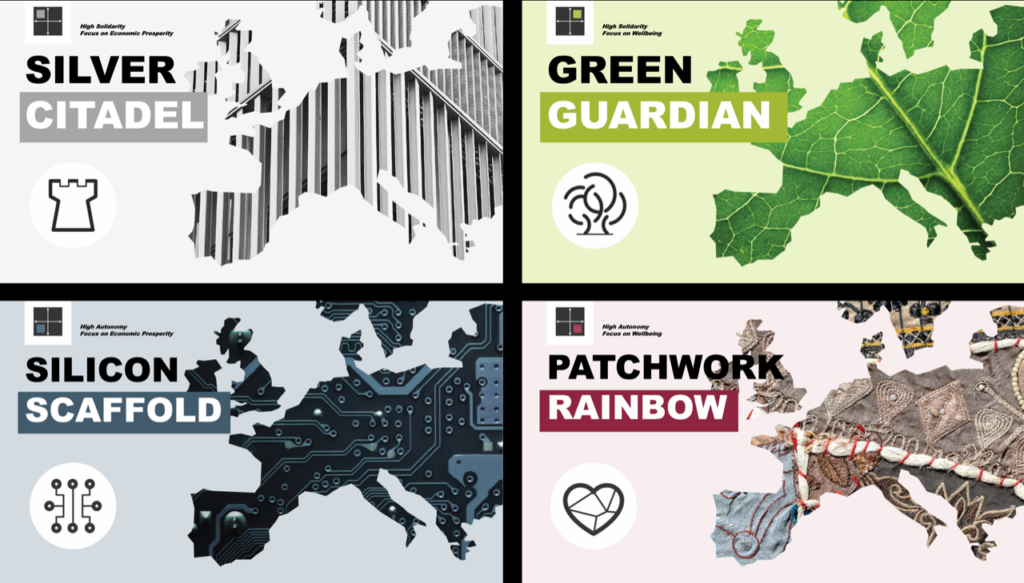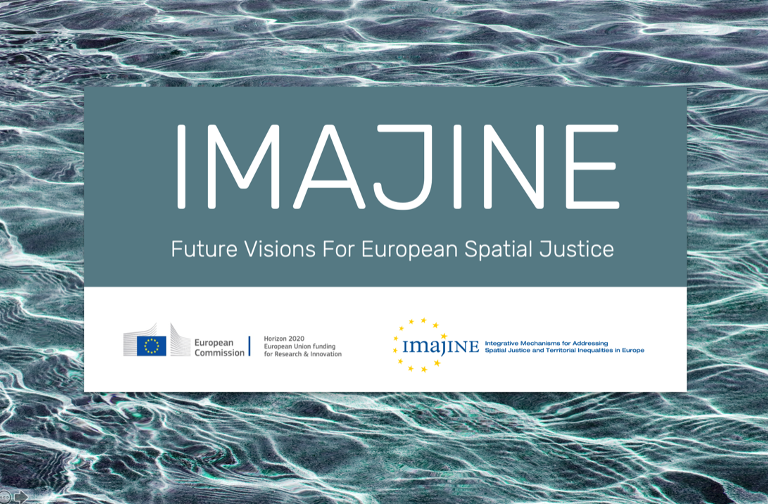“In this fragmented, digital Europe, citizenship is more like a software subscription. The lines between government and business blur, and a successful region like ‘Tesla-Brandenburg’ thrives thanks to its world-spanning corporate connections.” – ‘Silicon Scaffold’, 2048
How can dreaming up futures which might never happen help communities to build resilience and address the challenges of a changing world?
The IMAJINE project is a European Commission-funded research programme exploring the question of “spatial justice”: whether people are treated fairly on the basis of the places where they live and work. Understanding geographical inequalities and injustices doesn’t just mean measuring the distance between today’s “haves” and “have-nots”, then tracking whether the gap narrows or grows wider. It means developing an understanding of fairness, and reflecting on how that understanding may evolve in times to come.
As Ursula K. Le Guin put it,
“We will not know our own injustice if we cannot imagine justice. We will not be free if we do not imagine freedom.”
IMAJINE’s four bold, challenging scenarios for the future of Europe in 2048 are not predictions, nor are they expressions of desired futures. They represent plausible, challenging future contexts which policymakers, institutions, and citizens may have to navigate in times to come. Each scenario challenges received wisdom about regional inequality and poses the question: what does justice look like in a world of turbulence, uncertainty, and change?
Each scenario has implications for energy, agriculture, the economy, the environment, and our fundamental ways of life. For practitioners focused on sustainability and resilience, they offer us an opportunity to test how our approach to problems, solution sets, and theories of change might hold – or fail – in different futures.
The scenarios also help to bring together conversations on sustainability and resilience. Sustainability spans scales, but often makes headlines for global or regional reasons. Resilience tends toward the local level, focused on places and communities. Where does that leave either agenda if our future lives inhabit virtual environments more than physical ones, as the ‘Silicon Scaffold’ scenario challenges us to consider? Near-infinite virtual geographies undermine the notion of ‘limits’ or ‘planetary boundaries’, common concerns in sustainability. The resources we use as we navigate digital worlds are hidden from us – we move, act and consume freely within them, even further removed from sustainability impacts than we are when we buy from a supermarket. Are resilience strategies deployed to cope with droughts or supply chain disruptions fit-for-purpose when we experience DDoS takedowns of our virtual workplaces and telehealth systems? Are sustainability and resilience flexible enough to guide us through such a future scenario, or should they be fundamentally recast and reframed?
Each IMAJINE scenario creates a mental sandbox in which our ideas, strategies, and plans can be tested. In these “soft spaces”, collaboration with stakeholders can happen more informally and experimentally, providing a way to explore strategies and pathways towards achieving a desired goal under various conditions. Through scenario work done in South Africa, Colombia, and Thailand, even deeply riven communities have been able to come together on the common ground of an unwritten future: “you and I disagree in the present, but we both know we need a better future for our children and grandchildren.”
The Oxford academic Eleanor Murray says that “resilient entities don’t bounce back, they bounce forward”. Resilience is not merely a question of how robust a system is, but the ways in which it adapts to shocks and stresses. Scenario work like the IMAJINE project provides a useful challenge by asking: what future are we going to bounce forward into?
Thinking in terms of imagined future contexts doesn’t mean that we deny all possibility of shaping the future. Instead it provides a useful dose of humility as we engage with the challenges of tomorrow and today. A farmer might not be able to control whether it rains or shines tomorrow, but working in concert with their wider society, their actions will have an impact on the climate, and whether their land still yields crops in times to come. Similarly, the IMAJINE scenarios encourage actors to consider how their choices today will interact with the systems they inhabit, and give those actors an opportunity to reflect on those choices from a unique perspective – a challenging magined future.
Through a cycle of reframing and reperception, moving between the future and the present, the scenarios can open people’s minds to opportunities and blindspots which are otherwise concealed by their current framing of a situation. How does the here-and-now look from the perspective of 2048? We invite you to take a moment to see yourself through the lens of IMAJINE’s four visions.

Silver Citadel presents a world in which spatial justice has come to be understood as the equitable distribution of wealth between regions, calculated using artificial intelligence. Material inequalities recede under a new state capitalism that includes reindustrialization and redistributive welfare, but some individuals struggle to make their voices heard by the centralized decision-making of ‘the algorithm’. Would sustainability stagnate if it became a metric-driven optimisation exercise, which overrode radical voices?
In Green Guardian, the EU consolidates its powers to manage resilience and sustainability on behalf of a new world order, focussed on surviving climate change and other crises. Talk of “profit” and “net worth” is traded for “yield” and “fair share”, and regions held historically responsible for climate change pay reparations overseas. In this highly anthropocentric view of sustainability thinking, what might slip through the cracks?
Silicon Scaffold is a future in which geopolitics is shaped by transnational corporations. The EU’s limited strength lies in regulating the infrastructure on which this virtual world runs, brokering digital access. Regions fight to hold on to wealth they have generated, and powerful business interests find innovative ways to export the environmental problems they cause to distant parts of the world, or even to orbit. What place would there be for sustainability and resilience in a future where people spent more time immersed in near-infinite digital worlds than they do engaging with real ones?
The final scenario, Patchwork Rainbow, sees spatial justice become a cultural issue: regions’ right to determine their own values matters above all in this version of 2048, and wildly varied ideas of identity, social value, wellbeing, and even truth proliferate across Europe. For some, this feels like a place where you can “choose your own paradise”, but for others, it feels like being cast back into the Middle Ages. In a future where divergent ideas thrived in specific niches but exchange was limited, would tidal, global-scale forces pose existential risks?

Plausibility and challenge: using 2048 to understand today
The IMAINE scenarios are designed to usefully challenge assumptions; they are neither dystopias nor utopias, but challenging opportunities to learn from events which haven’t happened yet. They serve as an invitation to contemplate what it would mean to inhabit futures which have diverged significantly from current expectations. This contemplation informs our understanding of justice and fairness between regions, in order to shape actions in the here and now. It helps us to make better decisions about what we seek to sustain, what forms of resilience we seek to cultivate, and how our decisions may be seen by those who succeed us and will live with their consequences.
The renowned scenario planner Pierre Wack said that scenarios were like looking at rain on the mountain and seeing that it might lead to floods in the valley below. Each of IMAJINE’s scenarios highlights different forces at work in Europe’s present, by showing some of the ways they might play out in years to come. Imagining such challenging futures doesn’t mean the floods are inevitable; instead, they help us to see how we might build a better, more rewarding, more just and more resilient life on the slopes of that mountain.
“Bioregioning encourages local sustainable energy generation, with any surplus distributed Europe-wide for the greater good. The EU develops massive offshore wind farms and other large-scale projects to share resources and reduce costs. Fossil fuels have been entirely abandoned.” – ‘Green Guardian’, 2048





